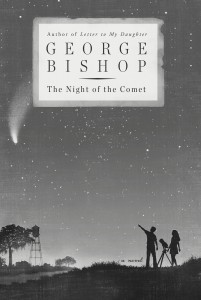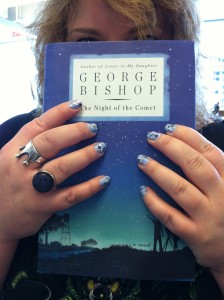Review of THE NIGHT OF THE COMET in the Wilmington Star News (NC). Thank you, Ben Steelman.
Eloquent Novel Explores Life After the Buzz Dies Down
By Ben Steelman
Published: Sunday, July 28, 2013 at 2:00 p.m.

In the world of spectacular fizzles, Comet Kohoutek ranks up there with the 1962 New York Mets, Rick Perry’s presidential campaign and the new “Lone Ranger” movie. Discovered in 1973, Kohoutek – named for the Czech astronomer who found it, not some ancient Egyptian god of doom – was hyped as “the Comet of the Century,” destined to outshine even Halley’s comet. Cults and preachers said it was an omen of Doomsday. Pink Floyd supposedly titled an early version of “Dark Side of the Moon” as “Eclipse Suite,” with Kohoutek in mind.
And then … nothing. Zilch. Kohoutek was barely visible to the naked eye. (Lots of people thought they saw it.) It was a major letdown.
Now, however, Louisiana writer George Bishop uses Kohoutek as a focus in his latest novel, “Night of the Comet.” Like Bishop’s earlier novel, “Letter to My Daughter,” it’s a coming-of-age yarn from a generation or three ago.
This time, the protagonist is 14-year-old Junior Broussard, just entering high school in Terrebone, La., in the fall of 1973.
The Carpenters and Three Dog Night are all over the radio; sensitive girls (like Junior’s hippie-wannabe sister, Megan) are up in their rooms playing Roberta Flack’s “Killing Me Softly” over and over. Everyone’s worried about the Arab oil embargo, which threatens to raise oil prices as high as $20 per barrel (Surprisingly, no one in Terrebone seems to care much about Watergate.)
For Junior’s dad, however, the top story is Kohoutek, front and center. The geeky science teacher at the local high school, Alan Broussard sees the comet as a sign of renewal, as a way to recapture the magic he felt when he dreamed of becoming a fulltime researcher.
Kohoutek, he’s convinced, will finally let him grab the attention of his listless freshman Earth Science students. He talks the local paper into letting him write a weekly “Groovy Science” column to spread the news. And for Junior’s 14th birthday, he gives his son the ultimate present: a Celestron telescope, the best for viewing Kohoutek.
Junior, however, prefers to focus his telescope on Gabriella, the impossibly beautiful blonde girl who just moved with her family into the big house just across the bayou. Gabriella normally wouldn’t notice Junior, who’s not a jock and has spent his school career blending into the background. With Kohoutek in the sky, though, maybe he can tempt her to check out his ‘scope.
Junior’s mom, meanwhile, is also focusing on the house across the bayou. She dreams of making friends with the Martellos, that nice couple from Shreveport (word is, he’s a big oilman) and breaking loose from the dreary routine of being a schoolteacher’s wife. With Barbara Martello, Lydia Broussard hatches the scheme for a “Comet Ball” (to raise money for her husband’s lab, of course) which would bring all the best people of Terrebone together for a glittering evening under the stars.
All of the Broussards, of course, are doomed to disappointment.
Except for one key point, “Night of the Comet” offers few surprises; we’ve all heard different versions of this story before. Bishop, however, proves eloquent at delineating teenaged angst and yearning. He does for acne what Herman Melville once did for whales.
He’s also acute on middle-age discontent, the realization that there’s no point in dreaming about what you’ll do when you grow up, because you’re already there, and that your life, miserable as it is, is as good as it’s likely to get.


